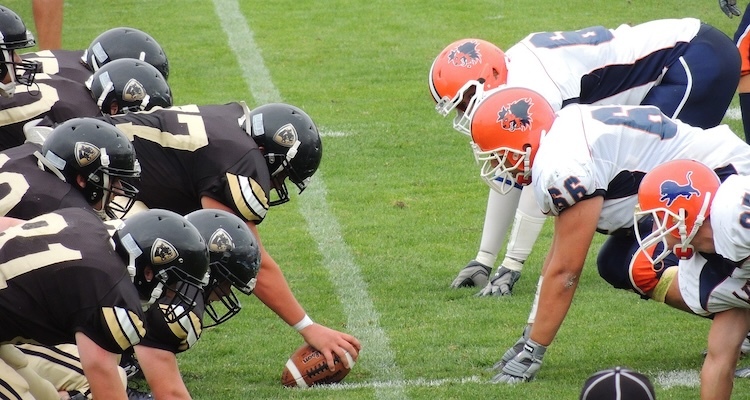
American football is a physically demanding sport due to its combination of intense physical exertion, high-impact collisions, and strategic complexity. Players are required to have a blend of strength, speed, agility, and endurance to perform effectively. The game involves frequent sprints, sudden changes in direction, and explosive movements, all of which place significant stress on the body. Additionally, players endure repeated tackles and blocks, leading to a high risk of injuries such as concussions, fractures, and muscle strains. The physical demands are compounded by the need for mental acuity, as players must quickly analyze and react to the dynamic flow of the game. The rigorous training regimens, including weightlifting, conditioning, and practice drills, further contribute to the sport's demanding nature. Overall, the combination of physical and mental challenges makes American football one of the most physically demanding sports.
Because of these physical demands playing American football can result in a wide range of injuries. Understanding these common injuries is essential for players, coaches, and medical professionals to implement preventive measures and effective treatments.
Concussions are a significant concern in American football due to the frequent head impacts players experience. A concussion is a type of traumatic brain injury caused by a blow to the head or a violent shaking of the head and body. Symptoms can range from headaches, dizziness, and confusion to memory loss and even unconsciousness. Repeated concussions can lead to chronic traumatic encephalopathy (CTE), a degenerative brain disease associated with long-term cognitive impairment and behavioral changes. The NFL and other football organizations have introduced protocols for assessing and managing concussions to mitigate these risks.
Knee injuries are prevalent in football, often resulting from the sport's sudden stops, starts, and directional changes. The anterior cruciate ligament (ACL) and the meniscus are particularly vulnerable. ACL injuries occur when the ligament that stabilizes the knee is torn, often requiring surgery and extensive rehabilitation. Meniscus tears, affecting the cartilage that cushions the knee joint, are also common and can result from twisting motions or direct impacts. Both injuries can sideline players for extended periods and may have long-term consequences for joint stability and function.
Ankle sprains are another frequent injury in football, typically resulting from twisting or rolling the ankle during play. These sprains can vary in severity from mild stretches of the ligaments to complete tears. High ankle sprains, which involve the ligaments above the ankle joint, are particularly troublesome and can take longer to heal. Proper taping, bracing, and strengthening exercises are crucial for prevention and recovery.
Shoulder injuries, including dislocations, separations, and rotator cuff tears, are common due to the physical nature of tackles and blocking. A dislocated shoulder occurs when the upper arm bone pops out of the shoulder socket, while a separation involves damage to the ligaments connecting the collarbone to the shoulder blade. Rotator cuff injuries affect the group of muscles and tendons stabilizing the shoulder joint, often caused by repetitive stress or acute trauma. These injuries can severely limit a player's ability to perform and may require surgical intervention.
Hamstring strains are prevalent among football players due to the explosive sprints and rapid accelerations required in the sport. A hamstring strain occurs when the muscles at the back of the thigh are overstretched or torn. This injury can range from mild strains, causing minor discomfort, to severe tears, leading to significant pain and mobility issues. Proper warm-ups, stretching, and strengthening exercises are essential to prevent hamstring strains.
Hand and wrist injuries are common in football, particularly among linemen and receivers. Fractures, dislocations, and ligament tears can result from direct impacts, falls, or awkward landings. Jammed fingers and wrist sprains are frequent, often requiring splints or casts for recovery. Despite their seemingly minor nature, these injuries can significantly impact a player's ability to catch, block, and tackle effectively.
The high-impact nature of football also predisposes players to back injuries, including muscle strains, herniated discs, and fractures. The lower back, or lumbar region, is especially vulnerable due to the stress from lifting, twisting, and tackling. Proper conditioning, strength training, and technique are vital in preventing back injuries, which can be debilitating and affect a player's long-term health.
Preventing injuries in football involves a combination of proper training, equipment, and adherence to safety protocols. Strength and conditioning programs tailored to enhance flexibility, balance, and muscular strength are fundamental. Wearing appropriate protective gear, such as helmets, pads, and braces, can mitigate the risk of severe injuries. Additionally, education on proper tackling techniques and rule enforcement to minimize dangerous plays are crucial.
When injuries occur, timely and appropriate management is critical. This includes immediate first aid, accurate diagnosis, and a comprehensive rehabilitation plan. Medical professionals, including athletic trainers, physiotherapists, sports therapists, and orthopedic specialists, play a vital role in the recovery process, ensuring players return to the field safely and effectively.
American football's physically demanding nature makes injuries an inherent part of the game. Understanding the common injuries—from concussions and knee injuries to ankle sprains and shoulder dislocations—helps in developing effective prevention and treatment strategies. Emphasizing safety, proper training, and medical care can help reduce the incidence and severity of injuries, allowing players to enjoy the sport while minimizing long-term health risks.
We have a number of sport injury specialists who advertise their services on our site. Visit our homepage for our easy to use online directory to find a sports injury specialist or clinic near you who can help with any American Football related injuries.
